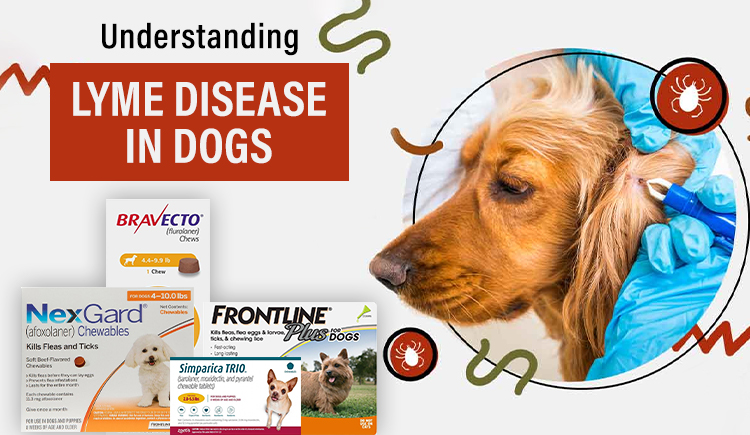
Lyme disease, caused by the bacterium Borrelia burgdorferi, is one of the most prevalent tick-borne diseases affecting dogs globally. Ticks transmit this bacteria when they bite, posing a significant health risk to our furry companions. Understanding the ins and outs of Lyme disease, including its signs, treatment options, and preventive measures, is essential for responsible pet parenting.
What is Lyme disease?
Lyme disease in dogs is a bacterial infection caused by the Borrelia burgdorferi bacterium, transmitted through tick bites. Ticks become infected with the bacteria when they feed on small mammals, such as mice and deer, which are carriers of the disease. When an infected tick bites a dog, it can transmit the bacteria, leading to Lyme disease. Prevention through tick control measures and regular veterinary check-ups is vital for safeguarding dogs against this potentially serious illness.
Signs and Symptoms
Early detection of Lyme disease symptoms is crucial for effective treatment. In the initial stages, dogs may exhibit nonspecific signs such as fever, lethargy, and decreased appetite. As the infection progresses, more specific symptoms may manifest, including lameness due to joint inflammation, swollen lymph nodes, and reluctance to move. In severe cases, dogs may develop kidney disease, leading to symptoms such as increased thirst and urination, vomiting, and weight loss. It’s essential to monitor your dog closely for any unusual behaviors or symptoms and consult your veterinarian promptly if you suspect Lyme disease.
Treatment and Prevention
Fortunately, Lyme disease in dogs is treatable, especially when diagnosed early. Your veterinarian may prescribe antibiotics such as doxycycline or amoxicillin to combat the bacterial infection. Additionally, tick control is paramount in managing Lyme disease. Products like NexGard, Frontline Plus, Simparica Trio, and Bravecto are highly effective in killing ticks and preventing the transmission of Lyme disease-causing bacteria. These medications disrupt the tick’s life cycle, effectively reducing the risk of tick-borne diseases in your dog. However, always consult your vet before starting any treatment regimen for your pet.
Where to Check for Ticks on Dogs
Ticks are stealthy parasites that often hide in warm, moist areas on your dog’s body. To ensure thorough tick checks, focus on these key areas:
1. Ears: Inspect inside and around the ears, as ticks may seek shelter in this warm and protected area.
2. Groin: Ticks may gravitate towards the groin area due to its warmth and accessibility.
4. Between Toes: Examine between your dog’s toes, where ticks can easily attach without being noticed.
5. Neck and Head: Pay close attention to the neck and head, including around the collar area and under the chin.
6. Tail: Check the base of the tail and along its length, as ticks may latch onto this area during outdoor activities.
7. Underbelly: Lift your dog’s legs to inspect the underbelly, as ticks may hide in the folds of skin or fur.
8. Back: Run your hands along your dog’s back, feeling for any bumps or irregularities that may indicate a tick presence

Regular tick checks in these areas can help you detect and remove ticks promptly, reducing the risk of tick-borne diseases like Lyme disease.
During your regular grooming sessions or outdoor adventures, pay close attention to these areas for any signs of tick infestation. Prompt removal of ticks is crucial to prevent the transmission of Lyme disease and other tick-borne illnesses.
Also, Read- 7 Ways to Protect Pets from Fleas and Ticks
How to Safely Remove Ticks from Your Dog
Removing ticks from your dog requires caution and precision to minimize the risk of infection or tick-borne disease transmission. Follow these steps for safe tick removal:

By following these steps, you can safely remove ticks from your dog and reduce the risk of tick-borne illnesses.
Conclusion
As responsible pet parents, it’s our duty to protect our furry friends from the dangers of tick-borne illnesses like Lyme disease. By understanding the risks associated with ticks and taking proactive measures to prevent tick bites, we can ensure our dogs lead healthy and happy lives. From regular tick checks to using effective tick control products like NexGard, Frontline Plus, Simparica Trio, and Bravecto, we have the power to shield our pets from the threat of Lyme disease and other tick-related health issues. Let’s commit to safeguarding our canine companions and enjoying many tick-free adventures together.

